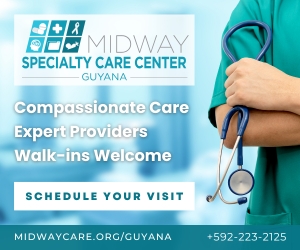Breast Cancer: Early Detection Saves Lives
Breast cancer is the most commonly diagnosed cancer and the second leading cause of cancer-related deaths in Guyana. Globally, significant disparities in breast cancer mortality persist. High-income countries have achieved relatively low death rates despite stable or increasing incidence, largely due to robust screening programs that enable early detection. In contrast, low- and middle-income nations experience much higher mortality rates, even with lower overall incidence, primarily because cancers are detected at more advanced stages.
In Guyana, the high mortality rate from breast cancer is largely due to limited access to screening services. As a result, many women are diagnosed at a late stage, when the cancer has already spread and is more difficult to treat successfully.
Recognizing the urgent need to address this issue, the Ministry of Health (MOH) has made breast cancer prevention and early detection a national priority. In April 2023, the Guyana Breast Screening Program (GBSP) Steering Committee was established to advise on a strategic roadmap for implementing a population-based breast cancer screening program.
By 2025, the Ministry significantly expanded the country’s mammography capacity—installing four new digital mammography units at hospitals in Lethem, Linden, Suddie, and New Amsterdam. This fivefold increase in capacity marks a major step forward in ensuring equitable access to life-saving screening services across the country.
The Importance of Early Detection
Reducing deaths from breast cancer depends on two key factors: early detection and effective treatment. Regular screening, awareness of risk factors, and healthy lifestyle choices all play vital roles in detecting breast cancer early—when it is most curable.
Mammography remains the only screening tool proven to reduce breast cancer mortality. The GBSP recommends annual mammograms for most women aged 40–74 who are at average risk.
If you have a family history of breast cancer or a personal history of chest radiation, you may be at higher risk. Risk assessment tools such as the Gail Model, combined with genetic testing, can help determine your individual risk. If you are considered high-risk, consult your doctor to discuss when to begin screening and which tests are most appropriate—whether mammography, contrast-enhanced mammography, MRI, or ultrasound.
What to Do If You Find a Lump
If you discover a lump, stay calm but act promptly. Do not ignore symptoms—see your doctor as soon as possible. Many breast lumps are benign, but if a lump is cancerous, delaying evaluation can allow it to progress.
Even if a lump is painless, it can still be cancerous. Pain is not always a symptom of breast cancer, so any new or unusual lump should be checked by a healthcare professional.
Other Warning Signs to Watch For
You should seek medical attention right away if you notice:
- New or acquired nipple inversion
- Nipple discharge (especially if spontaneous, from one duct, one breast, or clear/bloody)
- Skin changes such as dimpling (peau d’orange), redness, or nipple excoriation
- Localized breast pain
- An unexplained lump in the armpit (axilla)
Advancements in Diagnosis and Care
If a suspicious mass is found on your mammogram, do not be alarmed. Diagnostic technology in Guyana has advanced significantly. At the Georgetown Public Hospital Corporation (GPHC), patients can now undergo ultrasound-guided breast biopsies through a tiny incision—without the need for open surgery. The procedure is quick, nearly painless, and results are typically available within two weeks. Your surgeon will then discuss the next steps based on the findings.
What’s on the Horizon
The MOH continues to advance breast care in Guyana. In the coming months, GPHC will acquire its first MRI scanner capable of performing breast MRI, a first for the public health sector. Additionally, GPHC will receive two state-of-the-art mammography units equipped for tomosynthesis, contrast-enhanced mammography, and stereotactic biopsy.
These technologies will improve diagnostic precision, particularly for women at high risk or those with complex findings. Common uses include:
- High-risk screening
- Characterizing abnormal breast lesions
- Staging breast cancer
- Monitoring treatment response
The introduction of stereotactic biopsy will also allow women with suspicious microcalcifications to undergo a minimally invasive procedure that can determine whether the abnormality is cancerous, benign, or otherwise.
Tomosynthesis, also known as 3D mammography, represents a significant advancement in breast imaging technology. It enhances the detection of breast cancer and improves diagnostic accuracy.
Together we can make a difference
Breast cancer can affect any woman, regardless of age or background. But with awareness, screening, and improved healthcare services, lives can be saved.
I urge all women to know their risk, get screened regularly, and seek help if they notice changes. Families and communities also play an important role in supporting early detection.














